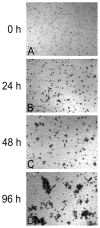Extracellular transport of cell-size particles and tumor cells by dendritic cells in culture
- PMID: 24145002
- PMCID: PMC3953141
- DOI: 10.1016/j.yexmp.2013.09.005
Extracellular transport of cell-size particles and tumor cells by dendritic cells in culture
Abstract
Many particulate materials of sizes approximating that of a cell disseminate after being introduced into the body. While some move about within phagocytic inflammatory cells, others appear to move about outside of, but in contact with, such cells. In this report, we provide unequivocal photomicroscopic evidence that cultured, mature, human dendritic cells can transport in extracellular fashion over significant distances both polymeric beads and tumor cells. At least in the case of polymeric beads, both fibrinogen and the β2-integrin subunit, CD18, appear to play important roles in the transport process. These discoveries may yield insight into a host of disease-related phenomena, including and especially tumor cell invasion and metastasis.
Keywords: Cancer; Cell-size particles; Chemotaxis; Dendritic cells; Directed migration; Extracellular transport; Inflammation; Metastasis; Tumor cells.
© 2013. Published by Elsevier Inc. All rights reserved.
Figures






Similar articles
-
A β2-Integrin/MRTF-A/SRF Pathway Regulates Dendritic Cell Gene Expression, Adhesion, and Traction Force Generation.Front Immunol. 2019 May 28;10:1138. doi: 10.3389/fimmu.2019.01138. eCollection 2019. Front Immunol. 2019. PMID: 31191527 Free PMC article.
-
Extracellular nucleotides regulate CCL20 release from human primary airway epithelial cells, monocytes and monocyte-derived dendritic cells.J Cell Physiol. 2007 Jun;211(3):716-27. doi: 10.1002/jcp.20979. J Cell Physiol. 2007. PMID: 17295217
-
The selective engulfment of apoptotic bodies by dendritic cells is mediated by the alpha(v)beta3 integrin and requires intracellular and extracellular calcium.Eur J Immunol. 1997 Aug;27(8):1893-900. doi: 10.1002/eji.1830270812. Eur J Immunol. 1997. PMID: 9295024
-
Activated apoptotic cells induce dendritic cell maturation via engagement of Toll-like receptor 4 (TLR4), dendritic cell-specific intercellular adhesion molecule 3 (ICAM-3)-grabbing nonintegrin (DC-SIGN), and β2 integrins.J Biol Chem. 2012 Apr 20;287(17):13731-42. doi: 10.1074/jbc.M111.336545. Epub 2012 Mar 6. J Biol Chem. 2012. PMID: 22396536 Free PMC article.
-
In vitro transformation of monocytes and dendritic cells into endothelial like cells.Adv Exp Med Biol. 2003;522:47-57. doi: 10.1007/978-1-4615-0169-5_6. Adv Exp Med Biol. 2003. PMID: 12674210 Review.
References
-
- Abbas AK, Lichtman AH. Cellular and Molecular Immunology. Saunders; Philadelphia: 2003a. Antigen Processing and Presentation to T Lymphocytes; pp. 88–90.
-
- Abbas AK, Lichtman AH. Cellular and Molecular Immunology. Saunders; Philadelphia: 2003b. Introduction to Immunology; pp. 24–26.
-
- Bachmann MF, et al. Chemokines: more than just road signs. Nat Rev Immunol. 2006;6:159–64. - PubMed
-
- Banchereau J, et al. Immunobiology of dendritic cells. Annu Rev Immunol. 2000;18:767–811. - PubMed
Publication types
MeSH terms
Substances
Grants and funding
LinkOut - more resources
Full Text Sources
Other Literature Sources
Medical
Molecular Biology Databases

